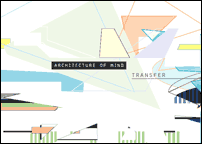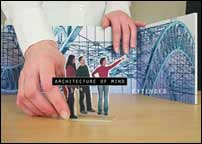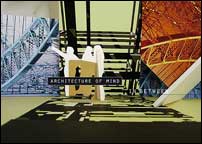





 |
 |
 |
 |
 |
 |
 |
||||||
| Overture In 2002, the ACC Galerie Weimar invited us in 2002 to present a joint exhibition. The space of the gallery - twelve exhibition rooms and corridors, sometimes mere hallways - is quite complex. Visitors often have the feeling of being in a maze with exits that appear unexpectedly. The medieval floor plan, the buildings slightly angled towards one another, the order of the rooms around the two courtyards: this all only becomes understandable when seen on an architectural plan. Within these walls, which already housed Goethe, the traveler to Weimar might expect anything - except contemporary art. In order to get a sense of the space, we did a test hanging on site, but we found ourselves dissatisfied with the situation. The large paper works seemed oversized in relation to the space, and the canvas paintings did not provide the contrast we were looking for. But we wanted an exhibition that provided productive linkages between our works and the space. After studying the rooms numerous times, we were convinced that we wanted to use the gallery’s complex structure as a matrix for our exhibition concept. The spatial construction has a life of its own, and evokes analogies to libraries and archives, or, in a very simple figurative sense, to the human brain. This inspired us to completely subordinate our works to the exhibition concept. “Architecture of Mind” took on concrete shape through the work on this first project. The ACC Concept Based on a three-dimensional model, the complex structure of the gallery was reconstructed under the aspect of an implemented temporal shift through space-transcending rhythmification and structuration. Large wall-drawings based on constructions and landscapes cloaked, disturbed, and extended the proportions and the rhythm of the gallery, thus adding other, autonomous structures to the spaces. What emerged was an expansive formation with multiple extensions that allowed the rooms to be linked to one another and to appear in a different context. Due to the optical illusion, the gallery seems to be subjected to compressions and distortions. The new structuration forms the framing system, in which in a few places small works were integrated into the space concept, which rhythmified the spatial character of the room through their character as objects. They took on the character of precious guides. Technique We painstakingly plotted out the gallery spaces and developed customized concepts for designing the individual rooms. In order to insure quick installation, all wall works were done on paper. Eight different rooms emerged, creating spatial and mental situations that also used elements taken from the architecture. In favor of the project, we fused our artistic signatures together, and worked on the individual wall pictures together. In particular for the oversized large surfaces, approximately 200 square meters, we developed a technique in which we used beeswax in large dimensions and experimented with oil paints and solvents. In so doing, we profited from the solid technical training we got at the Academy of Visual Arts in Leipzig, where we went to art school. The result of the experiments was transparencies and a material quality, as well as a treatment of the surface that dominated the theme of parallel worlds. The paper strips floated above the floor, and were only fastened. Their shadow on the floor underscored their character of a veil or a second skin. Catalogue Since besides our painting both of us work in the tradition of the Leipzig art books, this exhibit project resulted in an optimal symbiosis for designing a book. We invited the authors Meghan Hickey, Tanja Langer, and Andrew Patner to participate in the book project. With the exception of the text by Stanislaw Lem, the texts were written especially for the catalog, and the authors developed the texts to the concept of the exhibit. Stansilaw Lem’s backhanded and humorous story was furthermore a starting point of the developing the idea “Architecture of Mind.” In the linear sequence characteristic of the book as medium, the images and texts were rhythmically interlaced with one another. They deal with time and the perception of transformations, be they in reality or in a dream. The simultaneity and the rhythm, produced merely by the sequence of pages, appear like a trip on a Lemmian ship through space and time. Enriched with multiple biographies, bound together in the structure of the container (book), it evidences the ambivalence in our brains, with all the dark as well as light zones of our memory. The design of the pages influenced the conception of the exhibition, and vice versa. Final Remark We more or less began working in a shared studio on collective projects in 1998 in Chicago. There for the first time we developed together a conception of exhibition, which dealt with the presence and absence of home. “Travel” could not be realized. In 2000, Ulrike Dornis had just moved to Berlin, and we took part in the contest for the Alexanderplatz U-Bahn station. This work is the reconstruction of an existing artwork and developed during the course to the project to something of an ersatz paradise. |
 |
|||||
| invitation card for ACC Gallery, Weimar | ||||||
 |
||||||
| invitation card for gallery Inga Kondeyne, Berlin | ||||||
 |
||||||
| invitation card for gallery Kleindienst, Leipzig | ||||||
 |
||||||
| studio in Berlin | ||||||